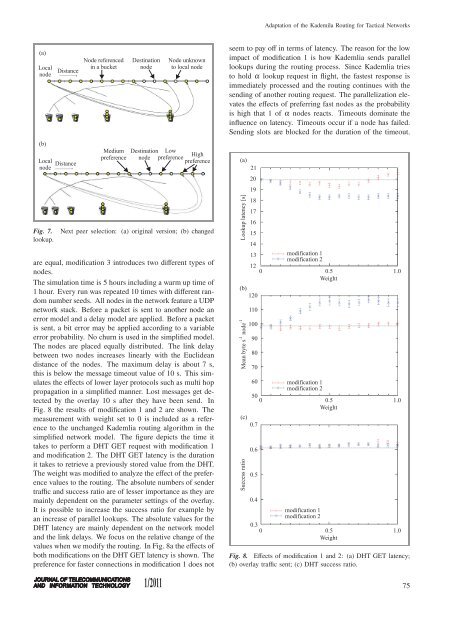Adaptation of the Kademila Routing for Tactical Networks
Adaptation of the Kademila Routing for Tactical Networks
Adaptation of the Kademila Routing for Tactical Networks
Create successful ePaper yourself
Turn your PDF publications into a flip-book with our unique Google optimized e-Paper software.
<strong>Adaptation</strong> <strong>of</strong> <strong>the</strong> <strong>Kademila</strong> <strong>Routing</strong> <strong>for</strong> <strong>Tactical</strong> <strong>Networks</strong><br />
seem to pay <strong>of</strong>f in terms <strong>of</strong> latency. The reason <strong>for</strong> <strong>the</strong> low<br />
impact <strong>of</strong> modification 1 is how Kademlia sends parallel<br />
lookups during <strong>the</strong> routing process. Since Kademlia tries<br />
to hold α lookup request in flight, <strong>the</strong> fastest response is<br />
immediately processed and <strong>the</strong> routing continues with <strong>the</strong><br />
sending <strong>of</strong> ano<strong>the</strong>r routing request. The parallelization elevates<br />
<strong>the</strong> effects <strong>of</strong> preferring fast nodes as <strong>the</strong> probability<br />
is high that 1 <strong>of</strong> α nodes reacts. Timeouts dominate <strong>the</strong><br />
influence on latency. Timeouts occur if a node has failed.<br />
Sending slots are blocked <strong>for</strong> <strong>the</strong> duration <strong>of</strong> <strong>the</strong> timeout.<br />
Fig. 7.<br />
lookup.<br />
Next peer selection: (a) original version; (b) changed<br />
are equal, modification 3 introduces two different types <strong>of</strong><br />
nodes.<br />
The simulation time is 5 hours including a warm up time <strong>of</strong><br />
1 hour. Every run was repeated 10 times with different random<br />
number seeds. All nodes in <strong>the</strong> network feature a UDP<br />
network stack. Be<strong>for</strong>e a packet is sent to ano<strong>the</strong>r node an<br />
error model and a delay model are applied. Be<strong>for</strong>e a packet<br />
is sent, a bit error may be applied according to a variable<br />
error probability. No churn is used in <strong>the</strong> simplified model.<br />
The nodes are placed equally distributed. The link delay<br />
between two nodes increases linearly with <strong>the</strong> Euclidean<br />
distance <strong>of</strong> <strong>the</strong> nodes. The maximum delay is about 7 s,<br />
this is below <strong>the</strong> message timeout value <strong>of</strong> 10 s. This simulates<br />
<strong>the</strong> effects <strong>of</strong> lower layer protocols such as multi hop<br />
propagation in a simplified manner. Lost messages get detected<br />
by <strong>the</strong> overlay 10 s after <strong>the</strong>y have been send. In<br />
Fig. 8 <strong>the</strong> results <strong>of</strong> modification 1 and 2 are shown. The<br />
measurement with weight set to 0 is included as a reference<br />
to <strong>the</strong> unchanged Kademlia routing algorithm in <strong>the</strong><br />
simplified network model. The figure depicts <strong>the</strong> time it<br />
takes to per<strong>for</strong>m a DHT GET request with modification 1<br />
and modification 2. The DHT GET latency is <strong>the</strong> duration<br />
it takes to retrieve a previously stored value from <strong>the</strong> DHT.<br />
The weight was modified to analyze <strong>the</strong> effect <strong>of</strong> <strong>the</strong> preference<br />
values to <strong>the</strong> routing. The absolute numbers <strong>of</strong> sender<br />
traffic and success ratio are <strong>of</strong> lesser importance as <strong>the</strong>y are<br />
mainly dependent on <strong>the</strong> parameter settings <strong>of</strong> <strong>the</strong> overlay.<br />
It is possible to increase <strong>the</strong> success ratio <strong>for</strong> example by<br />
an increase <strong>of</strong> parallel lookups. The absolute values <strong>for</strong> <strong>the</strong><br />
DHT latency are mainly dependent on <strong>the</strong> network model<br />
and <strong>the</strong> link delays. We focus on <strong>the</strong> relative change <strong>of</strong> <strong>the</strong><br />
values when we modify <strong>the</strong> routing. In Fig. 8a <strong>the</strong> effects <strong>of</strong><br />
both modifications on <strong>the</strong> DHT GET latency is shown. The<br />
preference <strong>for</strong> faster connections in modification 1 does not<br />
Fig. 8. Effects <strong>of</strong> modification 1 and 2: (a) DHT GET latency;<br />
(b) overlay traffic sent; (c) DHT success ratio.<br />
75

















